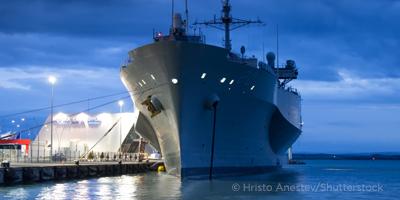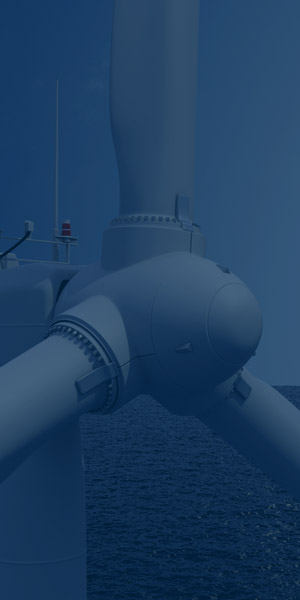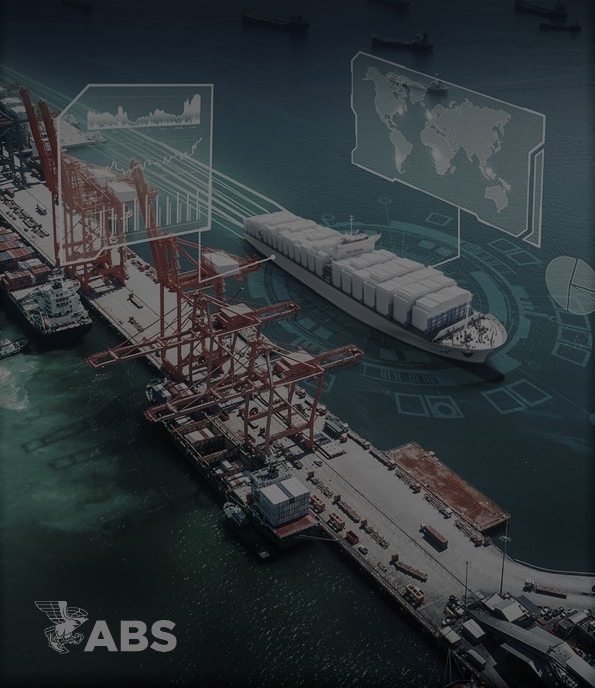Quick Links
- Rules and Resources
-
Services
Quick Links
Offshore- Production
- Offshore Support Vessels
- Exploration
- Offshore Wind Projects
- Offshore Wind Vessels
- Subsea Solutions
- Offshore Sustainability
- Offshore Space Support
- Floating Production Storage and Offloading (FPSOs)
- Offshore Energy Production
- Offshore Aquaculture
- Subsea Mining
- Novel Concepts and New Technologies
- Offshore Decommissioning
Sustainability and Decarbonization- Energy Efficiency Existing Ship Index (EEXI)
- Sustainability Reporting and Assurance
- Simulation-based Energy Efficiency Evaluation Service (SIM EEE)
- Greenhouse Gas Inventory and Carbon Accounting
- Carbon Capture, Utilization, and Storage (CCUS)
- Alternative Fuel Options
- Alternative Power Sources
- Marine Sustainability
- Offshore Sustainability
- Green Shipping Corridors
- Methanol Value Chain
- Gas
- Carbon Intensity Indicator (CII)
- Ammonia Value Chain
- Carbon Diligence Platform
- Greenhouse Gas (GHG) Rating Improvement
- Innovation and Technology
-
News and Events
Quick Links
-
About
Quick Links
- Rules and Resources
- Services
- Innovation and Technology
- News and Events
- About Us and Careers
- Rules and Resources
- Rules and Guides
- Regulatory Updates
- Advisories and Debriefs
- Flag and Port State
- Engineering Software
- Engineering Reviews
- ABS MyFreedom™ Portal
- Databases
- Forms
- Services
- Classification
- Approval and Certification
- Company and Ship Audits
- Global Marine
- Global Offshore
- Global Government
- Sustainability and Decarbonization
- Digital Solutions
- Cybersecurity
- Maritime Training
- Innovation and Technology
- Technology Advancement
- Academic Engagement
- Industry Partnerships
- Data and Digitalization
- Knowledge Center
- About Us and Careers
- Who We Are
- Safety
- Careers
- Contact Us
Smarter Lashing
Smarter Lashing
Securing containers safely is becoming a more complex endeavor given the challenges introduced by larger containerships, higher container stacks, more sophisticated lashing bridges and increased stack weights. To address these complexities, ABS published the ABS Guide for Certification of Container Securing Systems and offers companion software, ABS C-LASH®.
Guidance and Notations
Central to the lashing Guide is the nonlinear calculation procedure that represents a significant improvement over traditional formulas for container securing. The Guide helps users evaluate mixed, external and internal lashings at multiple tiers and multiple lashing points, taking into account the twistlock gaps and the effect of longitudinal lashing bridge flexibility. The advanced ability to account for these variables allows owners and operators to make smarter and more informed decisions on cargo distribution and lashing arrangements.
Vessels with systems designed, constructed, installed and surveyed in compliance with this Guide are eligible for the following notations:
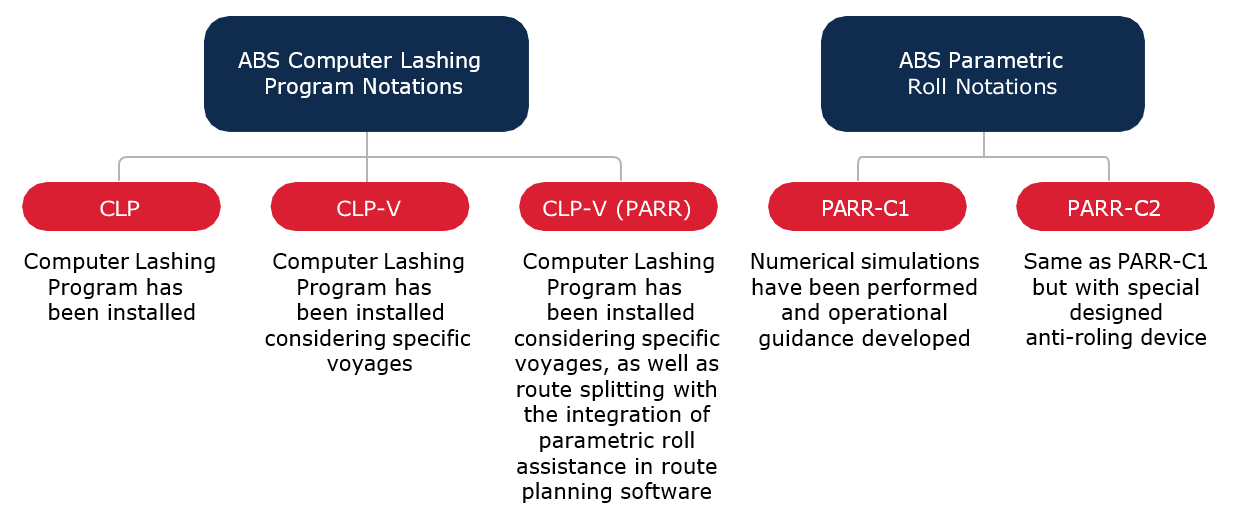
WHY CHOOSE CLP-V (PARR)?
The notation CLP-V (PARR) applies to computer lashing programs that take into consideration specific voyages and route splitting based on the integration of parametric roll assistance in route planning software. Route splitting is applicable for all standard routes, per the ABS lashing Guide as well as nonstandard routes. Typical route-specific trades can be split up and lower reduction factors for transverse acceleration can be applied to certain route sections.

Software
ABS C-LASH uses a series of carefully developed and validated equations that take into account the nonlinearities due to lashing rods and twistlock clearances without the need for an iterative solution process.
VERSION 6.1 UPDATES:
- Wind shielding factor based on computational fluid dynamics (CFD) studies.
- Improved loading capabilities on outer rows.
- Ability to add non-linear calculation procedures for internal lashing of outer rows.
- Currently non-linear procedures are only required for external lashing. This update will extend the applicability of nonlinear procedures to internal lashing as well.
- Better calculation methods resulting in more precision.
THE BENEFITS OF USING THE ABS C-LASH SOFTWARE INCLUDE:
- Flexibility — All container, lashing rod and twistlock properties and their connections are specified individually for each tier, providing the user with maximum flexibility in the analysis.
- Compatibility — C-LASH fully meets the requirements for nonlinear container stack analysis specified in the ABS Guide for Certification of Container Securing Systems and has been extensively tested against C-LASH Pro and state-of-the-art commercial finite element nonlinear solutions.
- Onboard application — Due to its accuracy, efficiency and reliability, the ABS C-LASH procedure is ideally suited for integration with onboard container loading instruments by means of a Dynamic- Link Library (DLL), allowing owners and operators to analyze hundreds of container stacks using a sophisticated nonlinear approach in just a few seconds
Analysis
Applicable to any containership operating in the world today, ABS offers a service to analyze existing lashing systems utilizing ABS C-LASH software. By modeling an existing lashing arrangement using the most modern nonlinear analysis methodologies, we have the opportunity to identify possibilities for improvements in the cargo securing system.
ABS C-LASH supports designers, owners and operators in developing and maintaining smart lashing systems, reducing risks and increasing safety and operational efficiency.
© 2024 American Bureau of Shipping. All rights reserved.











